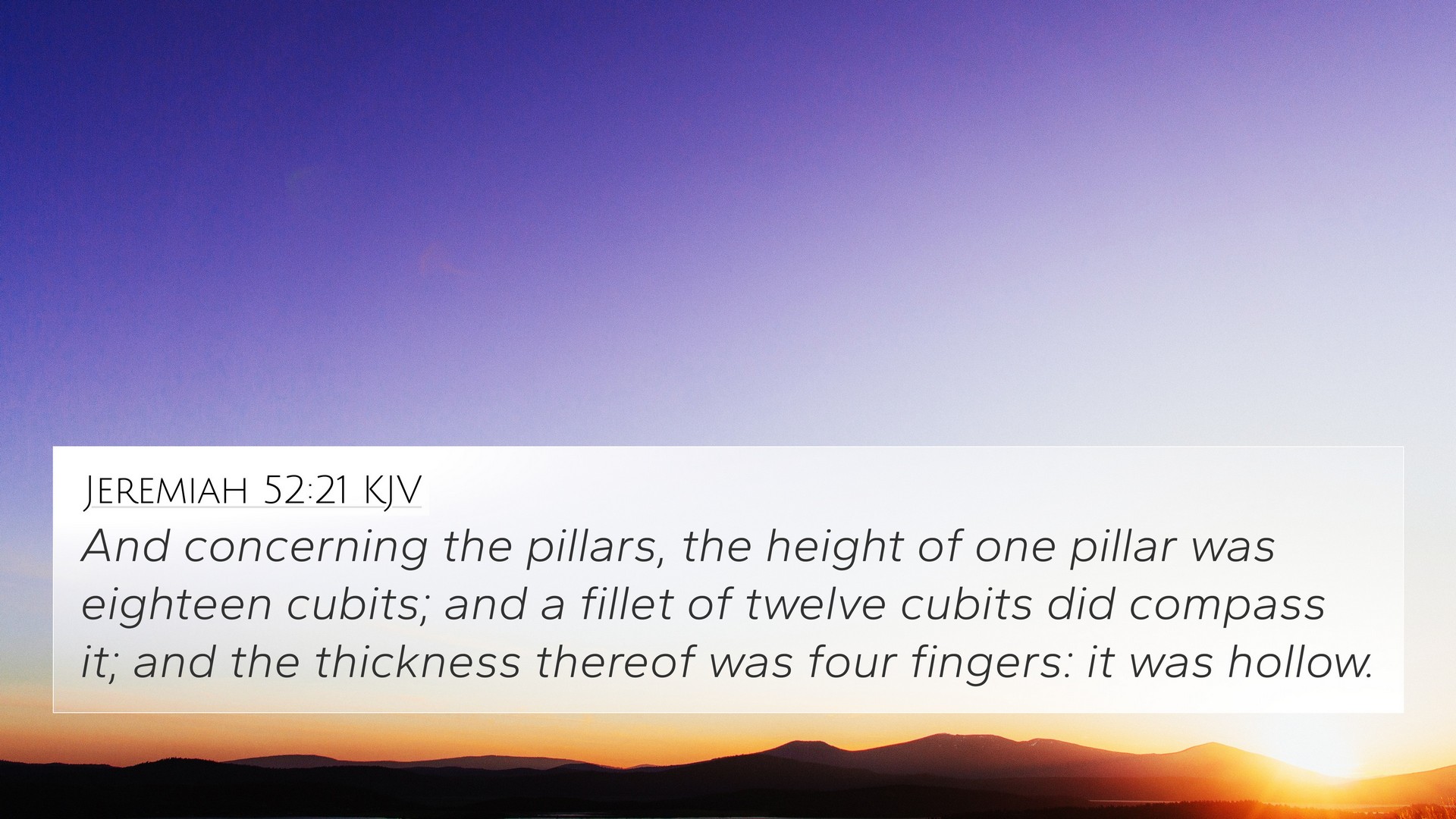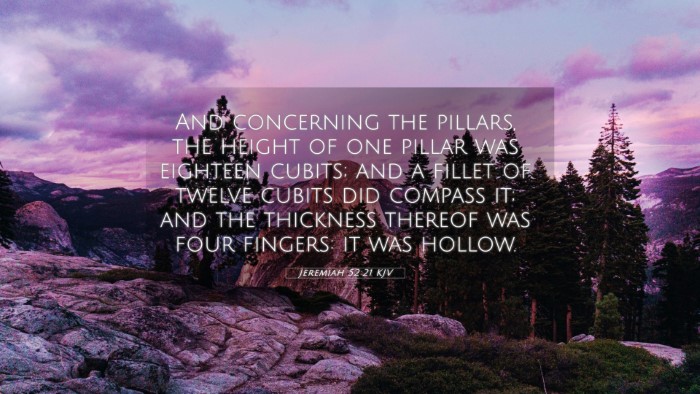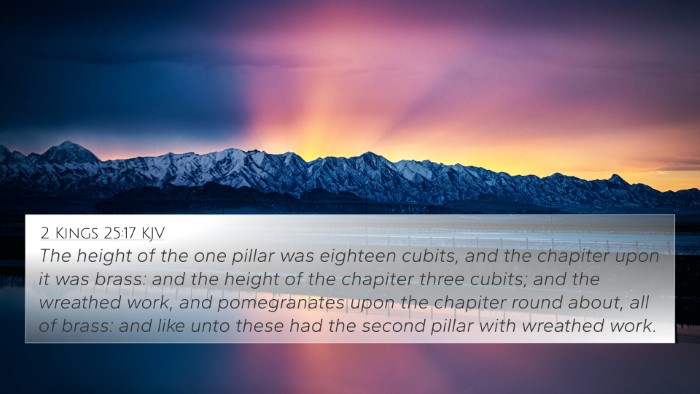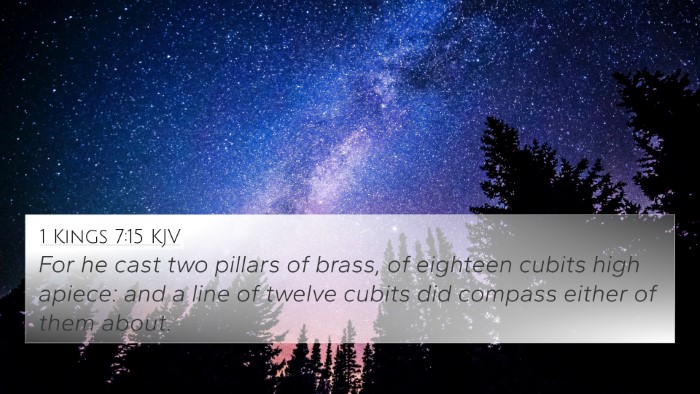Understanding Jeremiah 52:21
Jeremiah 52:21 states: “And concerning the pillars, the height of one pillar was eighteen cubits; and a fillet of twelve cubits did compass it, and the thickness of it was four fingers: it was hollow.” This verse details the pillars of the temple, which hold significant symbolic meaning in the Biblical narrative.
Summary of the Verse
This verse elaborates on the physical dimensions and characteristics of one of the pillars in the temple of Solomon. It highlights the significant height, encasement, and hollow nature of the pillar, which can be reflective of both artistic and theological ideas. The pillars are often seen as symbols of strength and stability within the sacred structure.
Commentary Insights
Matthew Henry notes that the description of the pillars reveals not only the grandeur of the temple but also serves as a metaphor for the strength and permanence of God’s promises. The measurement of the pillars symbolizes the measures God takes to ensure His covenant with His people.
Albert Barnes adds that the specific dimensions mentioned serve to connect the physicality of God’s dwelling place with the spiritual significance that it brings to the Israelites. He emphasizes that dimensions were not simply for construction but also for teaching the Israelites about God’s majesty.
Adam Clarke focuses on the idea of hollow pillars, interpreting this as a reminder of the nature of mankind: while they may seem strong outwardly, they can be empty or lacking substance if not grounded in faith. This provides a critical perspective on the importance of inner spiritual integrity.
Thematic Connections
This verse can be linked to several themes found throughout the Bible:
- Strength and Stability: Reflected in Psalms 18:2, which speaks of the Lord as a “rock” and “fortress.”
- God’s Presence: Referencing Exodus 25:8 where God instructs the Israelites to build a sanctuary for His dwelling.
- Divine Promises: Seen in Deuteronomy 31:6 which encourages trust in God’s everlasting support.
- Symbolism of Pillars: 1 Timothy 3:15 describes the Church as “the pillar and ground of the truth.”
- Manifestation of God’s Glory: 2 Chronicles 7:1-2, where God's glory fills the temple, paralleling the significance of structural symbols.
- The Nature of Worship: Isaiah 66:1, which emphasizes God’s sovereignty over all earthly constructs.
- Faithfulness of God: Lamentations 3:22-23 speaks to His enduring mercies which are new every morning.
Bible Verse Cross-References
Several Bible verses offer a deeper understanding and connection to Jeremiah 52:21:
- 1 Kings 7:15-22 - Details the creation and significance of the pillars Jachin and Boaz.
- Exodus 40:18-38 - Describes the construction and setting up of the tabernacle, paralleling themes of divine habitation.
- Hebrews 3:3 - Compares the glory of Christ to that of Solomon’s temple.
- Zechariah 4:7 - Speaks of grace empowering the rebuilding of the Temple.
- Matthew 24:2 - Jesus speaks of the destruction of the temple, highlighting its significance through Jewish history.
- Revelation 21:22 - Discusses the New Jerusalem and the absence of a temple in the eternal state, showing progress in God’s plans.
- 2 Samuel 7:13 - God’s promise to David about establishing a house for His name, pointing to the Temple and its pillars.
Conclusions
Jeremiah 52:21 provides not just the architectural dimensions of a pillar but invites us to reflect on deeper spiritual truths. The pillars represent stability in a believer's faith, signify God’s presence among His people, and embody the unshakeable promises of God. Understanding this verse through the lens of cross-references enhances our insight into the overarching themes of strength, divine glory, and the importance of inner spiritual integrity.
Tools for Bible Cross-Referencing
For those interested in delving deeper into cross-referencing, consider various tools and methods:
- Bible Concordance: A necessary tool for finding specific verses and their connections.
- Bible Cross-Reference Guide: A comprehensive guide can aid in navigating thematic links.
- Cross-Reference Bible Study: A systematic method for studying interconnected verses which enhances understanding.
- Bible Reference Resources: Utilizing commentaries and scholarly articles can provide greater insights.
- Comprehensive Bible Cross-Reference Materials: Seeking detailed resources that delve into theological connections can deepen exploration.
Finding Cross-References in the Bible
To enhance your study, consider the following methods:
- Identifying connections between Old and New Testament: Look for prophetic fulfillments or teachings echoed in the Gospel.
- Links between the Prophets and Apostolic teachings: Evaluate how the messages of Old Testament prophets resonate in the letters of Paul.
- Cross-referencing themes in the Bible: Engage in thematic study to see how various scriptures converge on common messages.
This comprehensive guide not only elucidates Jeremiah 52:21 but encourages a rich engagement with Scripture, empowering believers to find deeper meanings through effective Bible verse cross-referencing.





